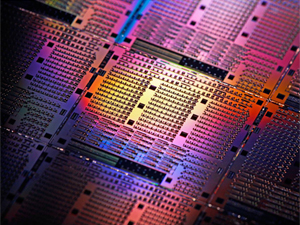



Date:16/06/16
 Yale scientists have found a way to greatly boost the intensity of light waves on a silicon microchip using the power of sound.
Yale scientists have found a way to greatly boost the intensity of light waves on a silicon microchip using the power of sound.
Writing in the journal Nature Photonics, a team led by Peter Rakich describes a new waveguide system that harnesses the ability to precisely control the interaction of light and sound waves. This work solves a long-standing problem of how to utilize this interaction in a robust manner on a silicon chip as the basis for powerful new signal-processing technologies.
The prevalence of silicon chips in today's technology makes the new system particularly advantageous, the researchers note. "Silicon is the basis for practically all microchip technologies," said Rakich, who is an assistant professor of applied physics and physics at Yale. "The ability to combine both light and sound in silicon permits us to control and process information in new ways that weren't otherwise possible."
Rakich said combining the two capabilities "is like giving a UPS driver an amphibious vehicle—you can find a much more efficient route for delivery when traveling by land or water."
These opportunities have motivated numerous groups around the world to explore such hybrid technologies on a silicon chip. However, progress was stifled because those devices weren't efficient enough for practical applications. The Yale group lifted this roadblock using new device designs that prevent light and sound from escaping the circuits.
"Figuring out how to shape this interaction without losing amplification was the real challenge," said Eric Kittlaus, a graduate student in Rakich's lab and the study's first author. "With precise control over the light-sound interaction, we will be able to create devices with immediate practical uses, including new types of lasers."
The researchers said there are commercial applications for the technology in a number of areas, including fiber-optic communications and signal processing. The system is part of a larger body of research the Rakich lab has conducted for the past five years, focused on designing new microchip technologies for light.
Heedeuk Shin, a former member of the Rakich lab who is now a professor at the Pohang University of Science and Technology in Korea, is the study's other co-author. "We're glad to help advance these new technologies, and are very excited to see what the future holds," Shin said.
Scientists amplify light using sound on a silicon chip
 Yale scientists have found a way to greatly boost the intensity of light waves on a silicon microchip using the power of sound.
Yale scientists have found a way to greatly boost the intensity of light waves on a silicon microchip using the power of sound.Writing in the journal Nature Photonics, a team led by Peter Rakich describes a new waveguide system that harnesses the ability to precisely control the interaction of light and sound waves. This work solves a long-standing problem of how to utilize this interaction in a robust manner on a silicon chip as the basis for powerful new signal-processing technologies.
The prevalence of silicon chips in today's technology makes the new system particularly advantageous, the researchers note. "Silicon is the basis for practically all microchip technologies," said Rakich, who is an assistant professor of applied physics and physics at Yale. "The ability to combine both light and sound in silicon permits us to control and process information in new ways that weren't otherwise possible."
Rakich said combining the two capabilities "is like giving a UPS driver an amphibious vehicle—you can find a much more efficient route for delivery when traveling by land or water."
These opportunities have motivated numerous groups around the world to explore such hybrid technologies on a silicon chip. However, progress was stifled because those devices weren't efficient enough for practical applications. The Yale group lifted this roadblock using new device designs that prevent light and sound from escaping the circuits.
"Figuring out how to shape this interaction without losing amplification was the real challenge," said Eric Kittlaus, a graduate student in Rakich's lab and the study's first author. "With precise control over the light-sound interaction, we will be able to create devices with immediate practical uses, including new types of lasers."
The researchers said there are commercial applications for the technology in a number of areas, including fiber-optic communications and signal processing. The system is part of a larger body of research the Rakich lab has conducted for the past five years, focused on designing new microchip technologies for light.
Heedeuk Shin, a former member of the Rakich lab who is now a professor at the Pohang University of Science and Technology in Korea, is the study's other co-author. "We're glad to help advance these new technologies, and are very excited to see what the future holds," Shin said.
Views: 456
©ictnews.az. All rights reserved.Similar news
- Azerbaijani project to monitor disease via mobile phones
- Innovative educational system to be improved under presidential decree
- NTRC prolongs license of two TV and radio organizations for 6 years
- Azerbaijan establishes e-registry for medicines
- Azerbaijani museum introduces e-guide
- Nar Mobile opens “Nar Dunyasi” sales and service center in Siyazan city
- International conference on custom electronic services held in Baku
- OIC secretary general to attend COMSTECH meeting in Baku
- Azerbaijan develops earthquake warning system
- New law to regulate transition to digital broadcasting in Azerbaijan
- Azerbaijani State Social Protection Fund introduces electronic digital signature
- Intellectual traffic management system in Baku to be commissioned in December
- Tax Ministry of Azerbaijan started receiving video-addresses
- World Bank recommends Azerbaijan to speed up e-service introduction in real estate
- Azerbaijan to shift to electronic registration of real estate





















